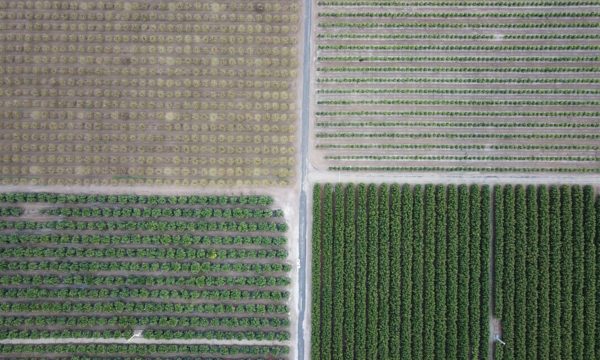 Water Wrights provides coverage of Central Valley water meetings. All coverage written by Don Wright.
Water Wrights provides coverage of Central Valley water meetings. All coverage written by Don Wright.
Read more meeting coverage and sign up for email service at WaterWrights.net
 The Pajaro Valley is home to a billion-dollar agricultural industry, it’s rich, fertile soil providing fruits and vegetables for the nation and all grown with groundwater. Located on the Central Coast, the Pajaro Valley has no connection to the State Water Project or to otherwise bring in imported water.
The Pajaro Valley is home to a billion-dollar agricultural industry, it’s rich, fertile soil providing fruits and vegetables for the nation and all grown with groundwater. Located on the Central Coast, the Pajaro Valley has no connection to the State Water Project or to otherwise bring in imported water.
In 1980, the Department of Water Resources published Bulletin 118, identifying the Pajaro Valley as one of eleven basins in the state considered critically overdrafted. Community leaders recognized that local management of the groundwater basin was necessary as seawater intrusion was already impacting agricultural water supplies as well as domestic wells; however, there was no single agency with authority to manage the entire basin which encompasses parts of Santa Cruz, Monterey, and San Benito counties as well as the City of Watsonville. So in 1984, local legislators spearheaded the state legislation necessary to form the a multi-jurisdictional agency to manage groundwater which was subsequently approved by local voters.
Since that time, the Pajaro Valley Water Management Agency has been working toward sustainable management of the Pajaro Valley’s water resources. At the 2019 Western Groundwater Congress, General Manager Brian Lockwood discussed the projects and programs the Agency is implementing as they work towards achieving groundwater sustainability.
Click here to read this article at Maven’s Notebook.
 Surface water commonly is hydraulically connected to ground water, but the interactions are difficult to observe and measure and have largely been ignored in water-management considerations and policies. However, the Sustainable Groundwater Management Act (SGMA), passed in 2014, is California’s first statewide law that explicitly reflects the fact that surface water and groundwater are frequently interconnected and that groundwater management can impact groundwater-dependent ecosystems, surface water flows, and the beneficial uses of those flows. The challenge of quantifying these interactions has led to the development of several techniques.
Surface water commonly is hydraulically connected to ground water, but the interactions are difficult to observe and measure and have largely been ignored in water-management considerations and policies. However, the Sustainable Groundwater Management Act (SGMA), passed in 2014, is California’s first statewide law that explicitly reflects the fact that surface water and groundwater are frequently interconnected and that groundwater management can impact groundwater-dependent ecosystems, surface water flows, and the beneficial uses of those flows. The challenge of quantifying these interactions has led to the development of several techniques.
At the 2019 Western Groundwater Congress, Gilbert Barth, PhD is an Associate and Senior Hydrologist with S.S. Papadopulos & Associates in their Boulder office, gave an overview of groundwater-surface water interactions and discussed some of the tools and techniques that he has helped develop. Dr. Barth provides quantitative assessments of groundwater resources to address questions associated with water planning, and specializes in model development and calibration with a focus on quantifying changes between surface water and groundwater systems. He’s developed and applied models throughout the Western US for regional, interstate, and international deliberations.
Click here to read this article.
 Eric Averett is General Manager with the Rosedale-Rio Bravo Water Storage District, which is one of several water districts within Kern County. Kern County is the largest basin in the state, is designated as critically overdrafted, and is arguably one of the most complex with respect to the number of water interests that are involved. In addition, they have had to deal with approximately 500,000 acres of undistricted or ‘white land’ areas. In this presentation from the Western Groundwater Congress, Mr. Averett discusses how his district and Kern County have been grappling with how to establish groundwater pumping allocations.
Eric Averett is General Manager with the Rosedale-Rio Bravo Water Storage District, which is one of several water districts within Kern County. Kern County is the largest basin in the state, is designated as critically overdrafted, and is arguably one of the most complex with respect to the number of water interests that are involved. In addition, they have had to deal with approximately 500,000 acres of undistricted or ‘white land’ areas. In this presentation from the Western Groundwater Congress, Mr. Averett discusses how his district and Kern County have been grappling with how to establish groundwater pumping allocations.
Click here to read this article.
 Sierra Ryan is a water resources planner with the County of Santa Cruz. In this presentation from the Groundwater Resources Association‘s 2019 Western Groundwater Congress, Ms. Ryan tells the story of how the Santa Cruz Mid-County Groundwater Agency balanced the various perspectives, authorities, and interpretations of the DWR regulations in writing the portion of their Groundwater Sustainability Plan that pertained to the depletion of interconnected surface water (sustainability indicator or undesirable result #6). “I promise you that it was not as simple as we thought it was to begin with, so for those of you in the medium and high priority basins that have the 2022 deadlines, I hope you’re thinking about this now,” Ms. Ryan advised. Click here to read this article at Maven’s Notebook.
Sierra Ryan is a water resources planner with the County of Santa Cruz. In this presentation from the Groundwater Resources Association‘s 2019 Western Groundwater Congress, Ms. Ryan tells the story of how the Santa Cruz Mid-County Groundwater Agency balanced the various perspectives, authorities, and interpretations of the DWR regulations in writing the portion of their Groundwater Sustainability Plan that pertained to the depletion of interconnected surface water (sustainability indicator or undesirable result #6). “I promise you that it was not as simple as we thought it was to begin with, so for those of you in the medium and high priority basins that have the 2022 deadlines, I hope you’re thinking about this now,” Ms. Ryan advised. Click here to read this article at Maven’s Notebook.
 Anna Schiller writes,
Anna Schiller writes,
“I wasn’t expecting to see egrets, herons and pelicans on my first trip to the San Joaquin Valley — a region in the southern part of California’s Central Valley known for its impressive agricultural production and scorching summer heat. I didn’t find these birds at one of the valley’s few wildlife refuges, but at a groundwater recharge facility designed to spread and infiltrate surface water into the ground below.
Recharge basins are becoming increasingly popular in overdrafted regions in California, where water managers are seeking solutions to balance groundwater supply and demand to comply with the state’s Sustainable Groundwater Management Act (SGMA). … ”
Continue reading at the Environmental Defense Fund’s Growing Returns blog.
 David Orth is the principal of New Current Water and Land, which offers strategic planning, program implementation, and water resource development services. At the California Irrigation Institute’s 2020 Annual Conference, he gave his observations on how implementation of the Sustainable Groundwater Management Act (SGMA) is progressing, having watched Groundwater Sustainability Agencies (GSAs) form and develop their Groundwater Sustainability Plans (GSPs) since the passage of the SGMA in 2014.
David Orth is the principal of New Current Water and Land, which offers strategic planning, program implementation, and water resource development services. At the California Irrigation Institute’s 2020 Annual Conference, he gave his observations on how implementation of the Sustainable Groundwater Management Act (SGMA) is progressing, having watched Groundwater Sustainability Agencies (GSAs) form and develop their Groundwater Sustainability Plans (GSPs) since the passage of the SGMA in 2014.
New Current Water and Land is a small strategic planning shop that combines experience in water engineering, finance, district management, and water law to create a strategic planning platform. Their clients are from the farming community, the investment community, and the lending community. They also work with one environmental NGO. Over the last several years, they have monitored over 60 GSAs on behalf on that client base in over 40 subbasins, including about 15 of the 21 subbasins that are considered critically overdrafted.
“Through the course of that, we’ve provided a general risk assessment for our clients by area so they can understand where they really need to pay attention as GSPs are developed in the policy engagement arena,” he said. “Then we extrapolated that into long-term forecasting of what individual ranch water budgets are going to look like upon full implementation of SGMA. This has assisted our ag clients in making decisions about redevelopment or acquisition or disposition in how to deal with the new variable that SGMA creates.”
Click here to read this article at Maven’s Notebook.
Water Wrights provides coverage from Central Valley water meetings, primarily in the San Joaquin Valley.
 MEETING COVERAGE
MEETING COVERAGE
COMMENTARY
ACWA/State Water Board webinar presentation outlines temporary and permanent options, including a new streamlined permitting pathway for standard water rights permits
 Almost five years ago, in the midst of a historic drought, the legislature passed the Sustainable Groundwater Management Act of 2014 (SGMA). The centerpiece of the legislation is the principle of local groundwater basin management, requiring the establishment of local Groundwater Sustainability Agencies (or GSAs) and the preparation of Groundwater Sustainability Plans (or GSPs) for groundwater basins statewide. The plans detail how the basin will be managed to avoid undesirable results, such as salt water intrusion or land subsidence, and to achieve sustainability managed basins over a 20 year planning and implementation horizon.
Almost five years ago, in the midst of a historic drought, the legislature passed the Sustainable Groundwater Management Act of 2014 (SGMA). The centerpiece of the legislation is the principle of local groundwater basin management, requiring the establishment of local Groundwater Sustainability Agencies (or GSAs) and the preparation of Groundwater Sustainability Plans (or GSPs) for groundwater basins statewide. The plans detail how the basin will be managed to avoid undesirable results, such as salt water intrusion or land subsidence, and to achieve sustainability managed basins over a 20 year planning and implementation horizon.
As many groundwater basins work to achieve sustainability, many if not most will look to groundwater recharge as a tool to help balance supplies and demands. At a webinar held at the end of last year, State Water Board staff discussed new permitting options for Groundwater Sustainability Agencies pursuing recharge projects.
 Water Wrights provides coverage of Central Valley water meetings. All coverage written by Don Wright.
Water Wrights provides coverage of Central Valley water meetings. All coverage written by Don Wright.







 Almost five years ago, in the midst of a historic drought, the legislature passed the Sustainable Groundwater Management Act of 2014 (SGMA). The centerpiece of the legislation is the principle of local groundwater basin management, requiring the establishment of local Groundwater Sustainability Agencies (or GSAs) and the preparation of Groundwater Sustainability Plans (or GSPs) for groundwater basins statewide. The plans detail how the basin will be managed to avoid undesirable results, such as salt water intrusion or land subsidence, and to achieve sustainability managed basins over a 20 year planning and implementation horizon.
Almost five years ago, in the midst of a historic drought, the legislature passed the Sustainable Groundwater Management Act of 2014 (SGMA). The centerpiece of the legislation is the principle of local groundwater basin management, requiring the establishment of local Groundwater Sustainability Agencies (or GSAs) and the preparation of Groundwater Sustainability Plans (or GSPs) for groundwater basins statewide. The plans detail how the basin will be managed to avoid undesirable results, such as salt water intrusion or land subsidence, and to achieve sustainability managed basins over a 20 year planning and implementation horizon.